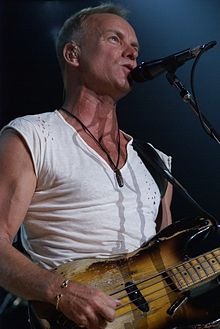University of Warwick
| University of Warwick | |
|---|---|
|
|
|
| Motto: | Latin: Mens agitat molem |
| Motto in English: | "Mind over matter" |
| Established: | 1965 |
| Type: | Public |
| Chancellor: | Richard Lambert |
| Vice-Chancellor: | Professor Nigel Thrift |
| Staff: | 4,871, incl. 1,128 academics and 707 researchers |
| Students: | 16,646 (full-time)[1] |
| Undergraduates: | 11,203[1] |
| Postgraduates: | 7,009[1] |
| Location: | Coventry, England, UK |
| Affiliations: | Russell Group, AMBA, EQUIS, Universities UK |
| Website: | http://www.warwick.ac.uk/ |
The University of Warwick is a British campus university located on the outskirts of Coventry, West Midlands, England and is regarded as one of the country's leading universities. It was established in 1965 as part of a government initiative to expand access to higher education, and in 2000 Warwick Medical School was opened as part of an initiative to train more doctors in Britain. In the last Research Assessment Exercise the University was the 5th highest-ranked research institution in the UK.[2]
In the 1960s and 1970s, Warwick had a reputation as a politically radical institution.[3] More recently, the University has been seen as a favoured institution of the British New Labour government.[4] Warwick was one of the first UK universities to develop close links with the business community, and has been successful in the commercialisation of research. This commercial approach has resulted in it being nicknamed "Warwick University Limited" (or, more recently, "Warwick University PLC").[5]
Warwick is a member of the Russell Group. It also used to be a member of the 1994 Group but left in July 2008.
The University's coat of arms includes atoms of two isotopes of lithium, a DNA helix to represent science and also the Bear and Ragged Staff of Warwickshire and the Elephant and Castle of Coventry. The bear is not chained in the current depiction of the University's coat of arms, although it was in earlier versions and in the letters patent issued by the College of Arms.[6]
Contents |
History
Establishment
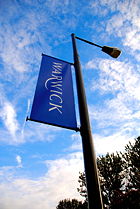
The idea for a university in Coventry was mooted shortly after the conclusion of the Second World War but it was a bold and imaginative partnership of the City and the County which brought the University into being on a 400-acre (1.6 km2) site jointly granted by the two authorities.[7] There was some discussion between local sponsors from both the city and county over whether it should be named after Coventry or Warwickshire.[7] The name "University of Warwick" was adopted, even though the county town of Warwick itself lies some 8 miles (13 km) to the southwest and Coventry city centre lies only 3.5 miles (5.5 km) northeast of the campus. [8] [9] [10] [11] The establishment of the University of Warwick was given approval by the government in 1961 and received its Royal Charter of Incorporation in 1965. Since then, the University has incorporated the former Coventry College of Education in 1979 and has extended its land holdings by the purchase of adjoining farm land. The University also benefited from a substantial donation from the family of Jack Martin, which enabled the construction of the Warwick Arts Centre.
The University is currently situated on a large 2.8 km² campus which straddles the boundary between the City of Coventry and the County of Warwickshire. The Central Campus contains all of the main student amenities, all but one of the student halls, and the Students' Union. It also has Barclays Bank, Natwest Bank, HSBC Bank, a laundrette, and a pharmacy.
Rapid growth
The University initially admitted a small intake of graduate students in 1964 and took its first 450 undergraduates in October 1965. The student population is now 16,646 (as of April 2008),[12] with around a third being postgraduates. 25% of the student body comes from overseas[13] and over 114 countries are represented on the campus. The University has 29 academic departments and over 40 research centres and institutes, in four Faculties: Arts, Medicine, Science and Social Studies. There are 1,607 academic staff, 844 research staff, and 5,168 total staff (as of April 2008).[12]
Since its establishment Warwick has expanded its grounds to 721 acres (2.9 km2) with many modern buildings and academic facilities, lakes and woodlands. A recent survey by The Times resulted in the campus being voted the best in the UK by a national poll of university students.
Architecture and policy
The campus originally consisted of distinctive Modern (1960s) architecture, in deliberate contrast with the medieval, classical, or "red brick" character of older Universities. The freedom given to academic departments combined with an aggressive and unapologetic commercial approach, both policies of the first Vice-Chancellor Lord Butterworth, were new innovations for UK Higher Education and have subsequently been copied by many other Universities.
Warwick is one of the few universities to reach its target for the proportion of state students admitted (86%). This may be due to the University's distinctive community policy and commitment to increasing access to higher education.
Chancellors
- William Rootes, 1st Baron Rootes, Chancellor-designate (died in December 1964 before taking office)
- Cyril Radcliffe, 1st Viscount Radcliffe (1965–1977)
- Leslie Scarman, Baron Scarman (1977–1989)
- Sir Shridath "Sonny" Ramphal (1989–2002)
- Sir Nicholas Scheele (2003–2008)
- Richard Lambert (2008-) [14]
Vice-Chancellors
- Lord Butterworth (1965–1985)
- Dr Clark L. Brundin (1985–1992)
- Professor Sir Brian K. Follett (1993–2001)
- Professor David VandeLinde (2001–2006)
- Professor Nigel Thrift (2006–present)
Campuses
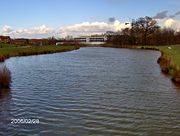
The University of Warwick () is located on the outskirts of Coventry, 5 km (3 miles) southwest of the city centre, and not in Warwick as its name suggests. The University comprises three contiguous campuses, all in easy walking distance of the others:
- The Main Campus
- The Gibbet Hill Campus — home to Biological Sciences and Warwick Medical School
- The Westwood Campus — home to the Institute of Education, some postgraduate facilities and residences
In addition, other University properties include:
- University of Warwick Science Park
- Clinical Sciences Building at University Hospital Coventry — part of the Warwick Medical School
- Warwick Horticulture Research International (HRI) Research & Conference Centre, Wellesbourne, Warwickshire
- Warwick Horticulture Research International (HRI) Research Centre, Kirton, Lincolnshire
Academic standards
Research
The University was ranked fifth for quality of research out of 124 of the institutions which took part in the UK Funding Councils' 2001 Research Assessment Exercise.[15] Over 91% of the University's academic staff are located in departments with top research ratings of 5 or 5*. Warwick is particularly renowned for its research in business and management, economics, international relations (which operates the largest centre for globalisation and regionalisation in Europe), mathematics, statistics, English language and literature, and theatre studies in which it received top ratings of 5* in the Research Assessment Exercise.
Rankings
Warwick is consistently placed among the elite in UK University rankings; it is one of only five universities to have never been outside the top ten in any national university ranking.
According to The Sunday Times' University Guide 2006, Warwick has the fourth highest place contention in the UK with about ten applicants for every place.[16] Admission to Warwick University became more competitive than ever this year, as the school accepted a record-low 10 percent of applicants in 2007, making it one of the most selective universities in the world.[17] The majority of its subjects are consistently in the top ten in subject wise rankings.[18]
In the World MBA rankings published by the Financial Times, Warwick ranked 14th in the world for its Executive MBA and 29th for its MBA. Furthermore, The Economist Intelligence Unit's Which MBA? Guide, published annually, ranked Warwick's Full-Time MBA program 23rd in the world; it was also ranked in the top 10 in Europe. [19].
According to The Sunday Times, September 2006: "In barely forty years, Warwick has established itself as a leading alternative to Oxford and Cambridge. It recruits some of the brightest students who are taught by staff often working at the cutting edge of their subjects."[20] The Guardian, in May 2007, described the University as "consistently rated among the best universities in the country. Warwick is something of a leader in the academic field."[21]
The Sunday Times released averages of all its tables over 10 years, ranking Warwick as 7th in the country from 1998 - 2007.[22]
In 2000 the Sutton Trust named Warwick as a leading university in the UK, placing it 7th overall.[23]
| 2009 | 2008 | 2007 | 2006 | 2005 | 2004 | 2003 | 2002 | 2001 | 2000 | 1999 | 1998 | 1997 | 1996 | 1995 | 1994 | 1993 | |
|---|---|---|---|---|---|---|---|---|---|---|---|---|---|---|---|---|---|
| Times Good University Guide | 6th[24] | 7th[25] | 8th[26] | 8th | 5th[27] | 8th | 6th[28][29] | 6th | 8th = | 8th = | 7th | 6th | 5th | 8th = | 8th | 8th = | |
| Guardian University Guide | 4th[30] | 8th[31] | 8th[32] | 9th[33] | 9th[34] | 9th[35] | |||||||||||
| Sunday Times University Guide | 7th[36] | 7th | 7th[36] | 6th[37] | 6th[37] | 5th | |||||||||||
| Daily Telegraph | 8th[38] | 9th[39] | |||||||||||||||
| FT Good University Guide | 6th | 10th | 9th | 9th | |||||||||||||
| The Independent /
Complete University Guide |
5th[40] | 8th | |||||||||||||||
| Times - HES QS World Rankings | 69th[41] | 57th[42] | 73rd[43] | 77th[44] | 80 th[45] |
Academic staff
Current and former notable members of academic staff at Warwick include:
Biological Sciences
- Sir Brian Follett, also formerly Warwick University's Vice-Chancellor (1993 to 2001)
Computer Science
- Mike Cowlishaw, creator of the REXX programming language.
- Hugh Darwen , creator of Tutorial D database language
- Mike Paterson FRS, director of the Centre for Discrete Mathematics and its Applications
Economics
- Nicholas Crafts
- Robin Naylor
- Andrew Oswald
- Robert Skidelsky, Baron Skidelsky
- Sir Nicholas Stern, former Chief Economist of the World Bank
English
- Andrew Davies, television screenwriter
- Maureen Freely, writer, author and translator of works by Orhan Pamuk
- Germaine Greer
- AL Kennedy
- China Miéville
Engineering and Warwick Manufacturing Group
- Lord Bhattacharyya, founder and Director of the Warwick Manufacturing Group
- Kevin Warwick, Cyborg researcher
History
- E.P. Thompson, Marxist historian and founding member of the CND
Law
- Shaheen Sardar Ali, current professor of law
- Patrick Atiyah, barrister and legal writer
- Upendra Baxi, current professor of law
- Roger Burridge, MBE, current head of the law school
- Paul Raffield, current lecturer in law; actor in Joking Apart
Mathematics and Statistics
- Brian Bowditch, mathematician renowned for his contributions to geometry and topology. He is also known for solving the angel problem.
- Jack Cohen, developmental biologist and xenobiologist (honorary professor)
- Robert MacKay FRS FInstP FIMA, mathematician specialised in dynamical systems and an ISI highly cited researcher
- David Preiss FRS, winner of the 2008 Pólya Prize for his contributions to analysis and geometric measure theory
- Miles Reid FRS, mathematician renowned for his work in algebraic geometry
- Ian Stewart FRS, mathematician, popular science author and an ISI highly cited researcher
- Sir Christopher Zeeman FRS, topologist and exponent of Catastrophe theory, founding professor of mathematics and former President of the London Mathematical Society; the new Mathematics and Statistics building has been named in his honour, latterly Principal of Hertford College, Oxford
Philosophy
- Angie Hobbs
- David Miller (philosopher)
Physics
- Sandra Chapman FInstP, professor. Expert in plasma astrophysics.
- Phil Woodruff FRS, professor. Expert on surface science (especially synchrotron radiation) and key witness in the Harold Shipman trial.
Politics and International Studies
- Wyn Grant, former Chair of the British Political Studies Association (PSA)[2002-2005], President of the PSA [2005-Present]. Leading British political scientist with particualar interest in comparative public policy.
- Richard Higgott, Director of the Warwick Commission to the World Bank.
- Ben Rosamond, expert on European integration and globalisation
- Jan Aart Scholte, globalisation expert.
Sociology
- Margaret Archer, professor, key theorist in critical realism and former president of International Sociological Association.
- Jim Beckford, professor emeritus, Fellow of British Academy.
- Robin Cohen, honorary professor.
- Steve Fuller (social epistemologist), professor, theorist in science and technology studies.
- John Rex, professor emeritus.
Ethnic Relations
- H. A. Hellyer, senior research fellow. Expert on Muslims in Europe and West-Muslim world relations.
Other
- The Coull String Quartet has been quartet-in-residence since 1977.
Future development
Vision 2020

In November 2005, the University of Warwick made public its vision for the year 2020 and outlined proposals for how it would like to develop its campus over the next 15 years. These proposals built upon recent construction activity which included a new Mathematics and Statistics Building, a new Computer Science Building, new Business School buildings, the new Heronbank Residences and an expanded Sports Centre. The proposals would see a shift in the "centre of gravity" on campus away from the Students' Union towards the new University House and a proposed "Academic Square", located around the new Maths and Computer Science buildings.
University House

In 2003 the University acquired the former Headquarters of the National Grid which it converted into its new University administration building (now called University House). The building includes a student learning centre called the "Learning Grid".
Singapore Campus
In 2004 the University publicly revealed that it planned to open a 10,000-student campus in Singapore. Due to concerns about academic freedom, cost and freedom of speech for students, many students and academic staff opposed the scheme. Following exhaustive research the matter was discussed by the University's Senate, which requested further research to be undertaken, in effect forcing the University to abandon the scheme. Attempts to establish some firm links with Singapore (albeit not necessarily a full physical campus) are continuing.
Campus life
Student life

Undergraduate student life at Warwick is divided into two phases. In the first year, student life revolves around campus and, in particular, the Students' Union (with its sports clubs, societies and entertainment facilities). In the second and third years, as students move off-campus, the focus shifts to either Leamington Spa or Earlsdon in Coventry. There has been criticism of the perceived focus of the entertainment events toward first year undergraduates resident on campus.
Campus facilities
Staff, students and visitors benefit from the many non-academic facilities on campus. As well as Warwick Arts Centre (see below), the University hosts a large leisure centre, comprising 25 m swimming pool, two sports halls, gymnasium, squash courts and rock-climbing facility. Elsewhere on campus are a number of other sports halls, outside tennis courts, 400 m athletics track, multi-purpose outdoor surfaces and cricket grounds. Sports facilities are being constantly expanded, following the commencement of Warwick Sport, a 2005 joint venture between the University and the Students' Union. Indoor tennis courts have recently been opened on the Westwood Campus sports venue and an Olympic-size swimming pool has been rumoured in the long-term, depending on Coventry City Council's priorities. Most of the University's sports facilities are open to the general public.
There is a Costcutter supermarket, pharmacy, three banks (HSBC, Natwest, and Barclays), hair salon, post office, copy shop, and travel agent STA Travel around campus. A Tesco is located at the nearby Cannon Park shopping centre, a short walk from the Maths and Stats building or Claycroft halls.
All food and drink outlets are operated by either Warwick Hospitality or the Students' Union.
Residence halls
Students' Union
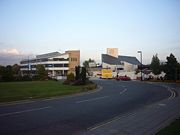
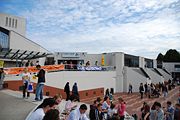
- See also: University of Warwick Students' Union
The University of Warwick Students' Union is one of the biggest Students' Unions in the UK, currently having over 200 societies and around 70 sports clubs, including everything from Squash to Skydiving. It has an annual turnover of approximately £6 million, the profit from which is used to provide services to students and to employ its staff and Sabbatical officers. The Union is divided into two buildings: Union North (mainly societies and administration) and Union South (entertainment facilities). Union South contains four club venues, seven bars and a cafe over four floors, with some "full Union (building)" events such as Top Banana and Skool Dayz. Drinks prices are not considered to be particularly cheap[46] but have recently been reduced for some events.
The Union has also recently hosted such bands as Ash, Sugababes, Amerie, The Kooks, Reel Big Fish, The Departure, The Subways, Idlewild, The Rory Mckenna variety show, Hell is for Heroes, The Automatic, The Dave Wright experience, Boy Kill Boy, Amy Winehouse, The Killers and Scouting for Girls.
The Union is a member of the National Union of Students (NUS), West Midlands Area NUS (WMANUS) and National Postgraduate Committee (NPC).
Student events
Each year in January, the University of Warwick plays host to the "world's largest student-run international event", One World Week[47]. Other student-run events include People & Planet's Go Green Week, Warwick International Development Summit, Warwick Economics Summit, RAG Week and Warwick Student Arts Festival.
The University is also home to the largest student-run Real Ale Festival in Great Britain, which takes place annually, always in the eighth week of second academic term. The festival is organised and staffed by the Warwick University Real Ale Society. A charity skydiving weekend, The Great Warwick Jump, was set up by the Skydiving Club in 2008 and is now the largest charity event at the University[48], raising £20,274.00 for charities worldwide in its first year.
Campus media
- Radio Warwick, also known as RaW, one of the most successful student radio stations in the UK
- Warwick Boar, an award-winning, weekly newspaper distributed free across campus each Tuesday
- Warwick Student Cinema, the university's student cinema housed in a large lecture theatre on campus, showing films on two 35 mm projectors most nights of the week.
- Dissident Warwick, a termly publication focussed on radical politics.
Warwick Arts Centre
- See also: Warwick Arts Centre
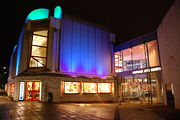
Situated at the centre of the University's main campus, the Warwick Arts Centre is the largest arts centre in the UK outside London.[49]
The centre comprises:
- The Butterworth Hall, a 1500-seat capacity concert hall
- A 550-seat theatre
- A 180-seat theatre studio
- A 220-seat cinema
- The Mead Gallery, an art gallery
Warwick Koan
White Koan, situated directly outside the main entrance of Warwick arts centre is a piece of modern art designed by the artist, Lilian Lijn[50][51]. The Koan is 6 m high[50], white in colour and decorated with elliptical of fluorescent lights. It is rotated by an electric motor whilst illuminated. The Koan is intended to represent the Buddhist quest for questions without answers (see koan). The Koan has been removed due to building works taking place in the Warwick Arts Centre, and it is unknown whether the Koan will return.
The Koan was originally made in 1971 as part of the Peter Stuyvesant Foundation City Sculpture Project and was first sited in Plymouth and then in London at the Hayward Gallery. It was purchased by the University in 1972[50].
Commercialism
Under the leadership of its first Vice-Chancellor, Lord Butterworth, Warwick was one of the first UK universities to adopt a business approach to higher education, develop close links with the business community and exploit the commercial value of its research.
Commercialisation of research
The University has established a number of stand-alone units to manage and extract commercial value from its research activities. The four most prominent examples of these units are:
- Warwick Manufacturing Group
- University of Warwick Science Park
- Warwick HRI
- Warwick Ventures
As a result of these activities, Warwick is the only UK University to generate more income through commercial activities than it receives from Government grants, which has allowed it to invest generously in facilities and undergo rapid growth. Research is the greatest source of income for the university, followed by overseas students and Warwick Accommodation.[52]
Warwick Conferences and Warwick Accommodation
Warwick was the first UK University to open its lecture and accommodation facilities to outside organisations, for profit, during the vacations. Warwick Conferences is now a thriving business, with its profits contributing to the University's financial independence, with dedicated, year-round conference centres, Scarman House and Radcliffe. Every year, on average 65,000 conference delegates are catered for, with services ranging from banqueting to access to sport facilities. Warwick Conferences has been recognised as one of the outstanding conference venues in the region and as such boasts among its collection, several awards including M&IT, Godiva, MIMA and CCE Chefs challenge awards.[53]
Warwick Accommodation provides on-campus accommodation for first-year undergraduates, final-year undergraduates (depending on availability) and postgraduate students. Off-campus accommodation is also provided and consists of privately owned houses which are University managed upon a commission charge. The location of such houses is usually within the catchment area of Coventry and Leamington Spa for student convenience.
Many of the 5700 on-campus rooms are used by conference guests outside of term-time. En suite rooms which include Arthur Vick, Jack Martin and Benefactors residences, as well as the standard single Rootes residence, are usually the primary allocation blocks for conference delegates.
Warwick Retail
The University has a small portfolio of businesses under the Warwick Retail umbrella, a private company wholly owned by the University.
Operations include:
- Costcutter Supermarket
- University Bookshop
- Oxfam Books, Music, Fashion and Fairtrade (opened April 2006, closed February 2008)
- Warwick Print (in-house publishing)
- CopyShop (previously called Lazerlizard) (stationery and reprographics)
The University also created and owns the temporary employment agency Unitemps[54] and the higher education recruitment website www.jobs.ac.uk.[55]
Finances
- Total University Income: £240.4m
- HEFCE Grants: £72
- Tuition Fees: £64.3m
- Research Grants and Contracts: £40m
- £77.6m of the University's total income is currently derived from "earning" activities such as self-financing short courses, research contracts, management training centres, vacation conferences, retail and catering.
Criticism
There has been some criticism that the University has become too commercially-minded at the expense of academic creativity and diversity. The most famous proponent of this critique was the noted historian E.P. Thompson, who wrote Warwick University Ltd in 1971.
Nevertheless, with the appointment of Sir Nicholas Scheele as Chancellor in 2002, the University signalled that it intended to continue and expand its commercial activities. In an interview for the BBC, Scheele said: "I think in the future, education and industry need to become even more closely linked than they have been historically. As government funding changes, the replacement could well come through private funding from companies, individuals and grant-giving agencies."[56]
Links with the Labour Government
Involvement with Government initiatives
Warwick has very close links to the Government and has been the academic partner for a number of flagship Government schemes including the National Academy for Gifted and Talented Youth and the NHS University (now defunct). Tony Blair described Warwick as "a beacon among British universities for its dynamism, quality and entrepreneurial zeal".[57]
Tuition/top-up fees
Warwick has been a strong supporter of the Government’s policy to introduce top-up fees. This has attracted strong criticism and regular protests from the Students’ Union and many academics, concerned that access to education will be based on ability to pay and not academic ability. In response, the University’s former Vice-Chancellor, David VandeLinde, called the policy "a positive one for Higher Education institutes" and promised "70% of the additional money derived from fees will be spent on further improving student services, facilities and support."[58]
Warwick is particularly well placed to benefit from Top-Up Fees as it is one of the few universities to meet its target, set by the Higher Education Funding Council for England, for the proportion of students enrolled from state schools (86%).[59] This means that it is unlikely to come under the scrutiny of the Office for Fair Access, an issue many other leading Universities are concerned about.
Bill Clinton presidential visit
On the recommendation of Tony Blair, Bill Clinton chose Warwick as the venue for his last major foreign policy address as US President in December 2000. Sandy Berger, Clinton’s National Security Advisor, explaining the decision in his Press Briefing on 7 December 2000, said that: "Warwick is one of Britain's newest and finest research universities, singled out by Prime Minister Blair as a model both of academic excellence and independence from the government."[60]
In his speech Clinton covered a number of issues, including Third World debt relief, fighting infectious diseases such as AIDS, basic education rights, and the "digital divide", which he summarized as the new development agenda for the 21st century. Clinton was accompanied by his wife Hillary Clinton and daughter Chelsea Clinton. During his visit, he planted a Pin Oak (Quercus palustris) sapling outside Senate House, the (then) university administration block.
The Warwick Agreement
The University of Warwick was the location for an important agreement between the Labour Party and the Trade Unions on Labour policy and trade union law, struck in July 2004. Subsequently the agreement has become popularly referred to as the Warwick Agreement. According to The Guardian, "it made peace between discontented elements in the unions and the government. It thereby averted the threat of mass disaffiliation from the party by the unions and helped to secure union support for Labour in the 2005 election."[61]
Governance
The University of Warwick is governed by three formal bodies: the Court, Council and the Senate. In addition to these, a Steering Committee provide strategic leadership in between meetings of the formal bodies. Faculties are overseen by Faculty Boards which report to the Senate.[62] The Principal Officers of the University have responsibility for day-to-day operations of the University. [63]
Notable alumni
Famous people to have attended the University of Warwick include:
Politicians
- Wendy Alexander – Former Labour leader in the Scottish Parliament

- Baroness Amos (Sociology, grad. 1976) – Britain's first female black Cabinet Minister, former Leader of the House of Lords and Lord President of the Council, now the European Union special representative to the African Union.
- Jon Cruddas (PhD in Philosophy, 1990) – Member of Parliament for Dagenham and candidate for the deputy leadership of the Labour Party.
- David Davis (Molecular Science/Computer Science, 1968–1971) – Conservative former Shadow Home Secretary

- Andrew Dismore (Bachelor of Laws), 1975 – Member of Parliament for Hendon
- Yakubu Gowon (PhD in Political Science) – former Nigerian Head of State
- Kim Howells – Foreign Office Minister
- Baroness Morris – former Labour Secretary of State for Education
- Brian Paddick - 2008 London Mayoral Candidate for the Liberal Democrats.
- George Saitoti – mathematician, politician, and former Vice-President of Kenya
- Valentine Strasser – former head of state of Sierra Leone (did not graduate)
- Kevin Taft - Leader of the Opposition in Alberta, Canada.
- George W. Kanyeihamba - member of the Supreme Court of Uganda and African Court on Human and Peoples' Rights, also Legal Advisor to the President of Uganda on Human Rights and International Affairs
- Sir Richard Leese = Leader of Manchester City Council.
Civil servants
- Ahmed Thasmeen Ali (Economics) – Home Minister of Maldives
- Sir Gus O'Donnell (Economics, grad. 1973) – Cabinet Secretary, the highest ranking civil servant in the British Civil Service
Academics
- H.A. Hellyer policy consultant and currently senior research fellow looking at Muslims in Europe
- Maris Martinsons – professor of management and international business consultant
- Ian Stewart FRS – popular science author and currently professor of mathematics
Journalists
- Jennie Bond (French and European Literature, grad. 1968) – former BBC Royal Correspondent
- Brian Deer (Philosophy) – The Sunday Times; Channel 4
- Tom Dunmore (Film & Literature; Editor In Chief, Stuff Magazine
Writers
- Nicholas Blincoe – author
- Simon Calder (Mathematics) – travel writer for The Independent
- Anne Fine (History, grad. 1968) – children's author and Fellow of the Royal Society of Literature
- James Franklin (Mathematics) – historian of ideas and philosopher
- A. L. Kennedy (Theatre and Performance Studies) – author
- To Kit (English Literature) – Hong Kong transmedia cultural and political commentater
- Tony Wheeler (Engineering, grad. 1968) – Co-founder of Lonely Planet (LP) travel guides

- Peter Linebaugh (History, grad. 1975) - author of Magna Carta Manifesto
Media
- Merfyn Jones – member of the Board of Governors of the BBC and vice-chancellor of the University of Wales, Bangor
- James King (Film and Literature) – BBC Radio 1 film critic
- Timmy Mallett (History, grad. 1977) – 1980s children's television presenter
- Simon Mayo (History and Politics, grad. 1981) – broadcaster
- Peter Salmon (European Literature, grad. 1977) – BBC television executive
Actors / Directors
- Paul W. S. Anderson (Film and Literature) – film director
- Vadim Jean (History) – film director
- Alex Jennings (English and Theatre Studies, grad. 1978) – actor who has performed in many lead roles at the RSC
- Ruth Jones (Theatre Studies and Dramatic Arts, grad. 1988) - actress best known for her role as Myfanwy in Little Britain and Nessa in Gavin and Stacey.
- Stephen Merchant (Film and Literature, grad. 1996) – wrote, directed and acted in the British television series The Office and Extras, in such roles as the 'Ooglemonster' and 'Darren Lamb' respectively.
- Frank Skinner, then Chris Collins (MA in English Literature, grad. 1981) – comedian/actor/writer
- Julian Rhind-Tutt (English) – actor best-known from the award-winning comedy series Green Wing
- Hannah Waterman – actress
Musicians
- Adem Ilhan – solo artist, and member of Fridge (studied mathematics)
- Sting – lead singer of The Police and solo artist (did not graduate)
- DJ Yoda – (English and American Literature grad. 1998) Hip hop turntablist
Entrepreneurs
- Ness Wadia – Indian Entrepreneur
Sport
- Steve Heighway (Economics) – Liverpool FC footballer
References
- ↑ 1.0 1.1 1.2 "University of Warwick Profile".
- ↑ University of Warwick Profile
- ↑ University of Warwick Student Union
- ↑ Halpin, Tony (2002-12-02). "Warwick's success hides a budget 'shortfall' of £20m", Times Newspaper. Retrieved on 2007-08-13.
- ↑ E. P. Thompson (1970). Warwick University Limited. Penguin. ISBN 0140802304.
- ↑ "The former logo". TinyPic. Retrieved on 2007-08-22.
- ↑ 7.0 7.1 Rees, H., A University is Born, Avalon Books, Coventry (1989)
- ↑ A compromise was proposed by Geoffrey Templeman, Deputy Chairman of the university's Planning Committee, who subsequently became the first Vice-Chancellor of the university on the border between the City of Canterbury and the county of Kent which faced a similar naming dispute and adopted the name University of Kent at Canterbury. However, the name the 'University of Warwick at Coventry' was not adopted.
- ↑ Graham Martin, From Vision to Reality: the Making of the University of Kent at Canterbury (1990) page 29n ISBN 0-904938-03-4
- ↑ Its creation was supported by University of Birmingham Vice-Chancellor Sir Robert Aitken who acted as 'Godfather to the University of Warwick'. The initial plan was for a university college at Coventry attached to Birmingham but Aitken advised an independent initiative to the University Grants Committee.
- ↑ Ives, E. (2000). The First Civic University: Birmingham, 1880–1980 – An Introductory History. Birmingham: University of Birmingham Press
- ↑ 12.0 12.1 Abbott, Tom (2008-04-11). "People - University Profile - The University of Warwick". University of Warwick. Retrieved on 2008-10-03.
- ↑ http://www.ukcosa.org.uk/about/statistics_he.php#table6
- ↑ New Chancellor Appointed
- ↑ http://education.guardian.co.uk/researchratings/table/0,11229,-4319756,00.html
- ↑ http://www2.warwick.ac.uk/services/international/offerholders/offer/
- ↑ "About University of Warwick". University of Warwick” (2008-05-01). Retrieved on 2008-05-01.
- ↑ "University of Warwick". The Good University Guide (2008-05-01). Retrieved on 2008-05-01.
- ↑ http://mba.eiu.com/(Which MBA?)
- ↑ "University of Warwick". Warwick Business School (2008-05-01). Retrieved on 2008-05-01.
- ↑ "University of Warwick". The Guardian (2007-05-01). Retrieved on 2007-11-06.
- ↑ "University ranking based on performance over 10 years". Times Online (2007). Retrieved on 2008-04-28.
- ↑ "Entry to Leading Universities". Sutton Trust (2000). Retrieved on 2008-04-28.
- ↑ "The Times Good University Guide 2009". The Times.
- ↑ "The Times Good University Guide 2008". The Times.
- ↑ "The Times Good University Guide 2007 - Top Universities 2007 League Table". The Times.
- ↑ "The Times Top Universities 2005". The Times.
- ↑ "University league table". The Daily Telegraph.
- ↑ "Times Good University Guide 2003 - Ignore the 2002 typo in the doucument".
- ↑ "University ranking by institution". The Guardian.
- ↑ "University ranking by institution". The Guardian.
- ↑ "University ranking by institution". The Guardian.
- ↑ "University ranking by institution". The Guardian.
- ↑ "University ranking by institution". The Guardian.
- ↑ "University league table". The Daily Telegraph.
- ↑ 36.0 36.1 "The Sunday Times Good University Guide League Tables". The Sunday Times.
- ↑ 37.0 37.1 "The Sunday Times University League Table". The Sunday Times.
- ↑ "University league table". The Daily Telegraph.
- ↑ "University league table". The Daily Telegraph Table of Tables.
- ↑ "The Independent University League Table". The Independent.
- ↑ "THES - QS World University Rankings 2008". THES. Retrieved on 2008-10-25.
- ↑ "THES - QS World University Rankings 2007". THES. Retrieved on 2007-11-10.
- ↑ "THES - QS World University Rankings 2006". THES. Retrieved on 2008-10-25.
- ↑ "THES - QS World University Rankings 2005". THES. Retrieved on 2008-10-25.
- ↑ "THES - QS World University Rankings 2004". THES. Retrieved on 2008-11-06.
- ↑ C. Saffrey and C. Williams, Campus drinks prices kept high, The Warwick Boar, 25 January 2005
- ↑ http://www.oneworldweek.net One World Week Website
- ↑ Target Skysports
- ↑ index: Warwick Arts Centre
- ↑ 50.0 50.1 50.2 "Lilian Lijn, Work". Retrieved on 2008-07-09.
- ↑ "University of Warwick Art Collection, White Koan". Retrieved on 2008-07-09.
- ↑ Service Promise
- ↑ http://www2.warwick.ac.uk/conferences/latestnews/awards/
- ↑ http://www.unitemps.co.uk
- ↑ http://www.jobs.ac.uk
- ↑ http://news.bbc.co.uk/1/hi/england/2342371.stm
- ↑ http://www2.warwick.ac.uk/services/communications/press/recentquotes/
- ↑ http://www.warwickboar.co.uk/boar/news/vc_on_topup_fees_i_dont_know_whats_going_to_happen/
- ↑ http://news.bbc.co.uk/1/hi/education/1070582.stm
- ↑ http://www2.warwick.ac.uk/services/communications/corporate/clinton/whitehousebrief/
- ↑ http://politics.guardian.co.uk/unions/story/0,,1569037,00.html
- ↑ http://www2.warwick.ac.uk/services/gov/introductiontogovernance/howgoverned/
- ↑ http://www2.warwick.ac.uk/services/gov/introductiontogovernance/universitymanagement/
External links
|
|||||
|
||||||||||||||||||||||||||||||||||||||||||||
|
|||||
|
||||||||||||||
